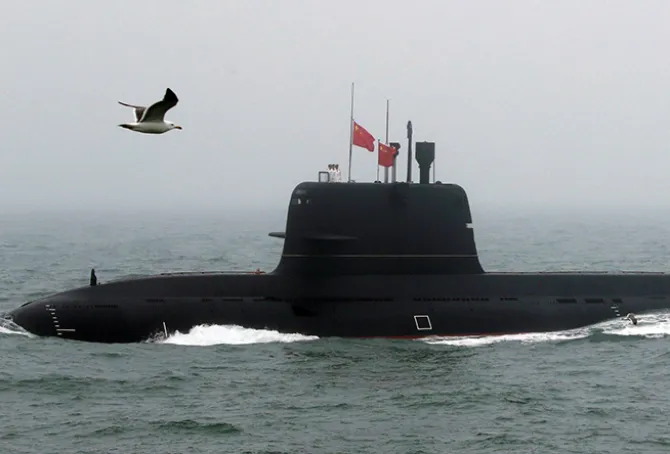
Trapped in the aft compartment of a nuclear submarine sitting on the bottom of the Barents Sea, a young Russian officer penned a note for the outside world, folded it neatly, and put it in his pocket. It was August 2000. Lieutenant-Captain Dimitri Kolesnikov, commander of the turbine room on the Russian submarine Kursk, was stranded with 22 comrades and facing imminent death. He wrote: “All personnel from compartments six, seven, and eight have moved to the ninth. There are 23 of us here. We have made this decision as a result of the accident. None of us can get out.” When rescuers arrived a few days later, Dimitri and his compatriots were found dead.
Both submarines were exercising in relatively shallow waters, albeit in different regions and 23 years apart, when a faulty system onboard set off a series of catastrophic events, killing nearly all crew members.
Last week's revelations about an accident aboard a Chinese submarine that reportedly killed 55 crew members, cast the mind back to the sinking of Kursk and its eerie parallels between the two accidents. Like the Kursk, the PLAN 093-417 is a nuclear attack submarine (SSN). Both submarines were exercising in relatively shallow waters, albeit in different regions and 23 years apart, when a faulty system onboard set off a series of catastrophic events, killing nearly all crew members. In both cases, naval authorities are suspected of delaying search and rescue. Russia, in August 2000, didn’t ask for foreign help until too late, and China has yet to even acknowledge the accident. The question remains: What possibly happened to PLAN 093-417? How did a nuclear submarine lose its entire crew, without being officially declared lost? Are there lessons to learn? Reports in the media are sketchy, but the Chinese submarine is supposed to have been snared by its own chain and anchor device, meant to catch Western vessels lurking off China's coast in the Yellow Sea. The incident supposedly occurred on 21 August, when the submarine inadvertently ran into a ‘chain and anchor’ trap set for British and American submarines, resulting in a breakdown of the oxygen generation system. It reportedly took over six hours for repairs to be carried out onboard, but by then, 22 officers, seven officer cadets, nine petty officers, and 17 sailors had suffocated to death.
The incident supposedly occurred on 21 August, when the submarine inadvertently ran into a ‘chain and anchor’ trap set for British and American submarines, resulting in a breakdown of the oxygen generation system.
The theory, many say, is implausible. Observers point out that in the aftermath of the alleged accident in the Yellow Sea, there were no reports of the PLAN having ordered a search and rescue. An accident aboard a nuclear submarine should have triggered a massive hunt. A sunken nuclear submarine with a live reactor core should have been a cause for alarm in the region and major capitals around the world. It curiously was not. Arguably, the PLAN didn’t raise a red flag because the submarine wasn’t reported as ‘lost’; crew members aboard were still engaged in repairs. But navy authorities ashore are likely to have known that an accident had occurred onboard the submarine. With the oxygen system failing, the command team onboard must have made some attempt to alert officials ashore about the accident. The crew would certainly have floated an emergency buoy if the submarine had been in any kind of danger. Oddly, there were no signs that the PLAN was rushing naval assets anywhere for a potential rescue. The claim that the PLAN built a trap for enemy submarines in the South China Sea is also questionable. Aside from the absurdity of the suggestion that the PLAN intended to capture a massive nuclear submarine in a wire net like an animal, the idea that China ordered the installation of a massive contraption out at sea, while fully aware that it would impede the PLAN’s own submarine operations, is highly dubious. If the PLAN had managed to “trap” an enemy submarine, what China would have done with it? Imagine the furore if a Western submarine caught in a Chinese net—fantastical as it sounds—went down to the bottom of the sea. The consequences would be terrible for Beijing.
A sunken nuclear submarine with a live reactor core should have been a cause for alarm in the region and major capitals around the world.
The more reasonable hypothesis comes from Taiwan’s media. Apparently, the accident aboard the PLAN 093-417 happened near Dalian—a port city in China—when a test torpedo exploded underwater, taking the submarine and its crew down. Apparently, the Liaoning Maritime Safety Administration issued a navigational warning for a military exercise off the coast of Dalian from 20–27 August. It then reportedly issued five repeated warnings for the area, ensuring it remained a no-sail zone from 20 August to 8 October, which, some say, is unusual—a possible indication of an accident in the region. But even this story does not explain why the PLAN was not actively looking for its nuclear submarine. If the submarine was physically secure and did eventually surface with all its crew members dead, no one seems to have seen it. With so many open-ended questions, it is hard to say what exactly happened to PLAN 093-417. So far, Beijing has revealed nothing. China’s military leadership is likely to be focused on the tactical and operational implications of the accident. The PLAN knows it has work to do, at least in the area of underwater warfare, where the gap with the US Navy is significant. The Type 93s are counted among China's most advanced and quietest subs; a malfunctioning oxygen generation system reveals a critical weakness and erodes the PLAN’s credibility as a power projection force. China’s naval leadership, to be sure, has long known the importance of shoring up the undersea deficit. Even since a mechanical malfunction on the Ming-class submarine 361 in May 2003 killed 70 sailors, the PLAN has striven to improve submarine capabilities. But it has never quite succeeded in ironing out the defects on its nuclear attack submarines.
The Liaoning Maritime Safety Administration issued a navigational warning for a military exercise off the coast of Dalian from 20–27 August.
That should be no reason for India to underestimate the PLAN. A reality that naval commanders know well is that submarine operations are inherently risky. Things happen at sea. The maritime environment is deeply unpredictable and there is no way of knowing what dangers present themselves, and when. Yet navies find a way to live with the hazards. The PLAN may have suffered a setback but it is bound to make amends. It won’t let its modernisation be hampered by one accident. India and its partners in the Indo-Pacific must stay vigilant.
Abhijit Singh is Head of the Maritime Policy Initiative at the Observer Research Foundation.
The views expressed above belong to the author(s). ORF research and analyses now available on Telegram! Click here to access our curated content — blogs, longforms and interviews.




 PREV
PREV


